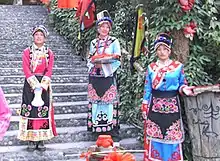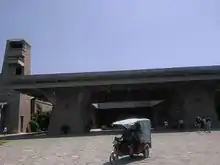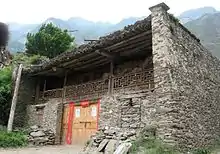Qiang people
The Qiang people (Chinese: 羌族; pinyin: Qiāngzú; Qiangic: Rrmea) are an ethnic group in China. They form one of the 56 ethnic groups officially recognized by China, with a population of approximately 310,000 in 2000.[1] They live mainly in a mountainous region in the northwestern part of Sichuan on the eastern edge of the Tibetan Plateau.[2]
Ch'iang, Chiang-Min, Erma | |
|---|---|
 | |
| Total population | |
| 300,000+ | |
| Regions with significant populations | |
| Sichuan, China: 300,000 | |
| Languages | |
| Qiangic languages | |
| Religion | |
| Qiang folk religion, Taoism, Tibetan Buddhism, Christianity and Islam. |
| Qiang people | |||||||||||||||||||||||||
|---|---|---|---|---|---|---|---|---|---|---|---|---|---|---|---|---|---|---|---|---|---|---|---|---|---|
| Chinese name | |||||||||||||||||||||||||
| Chinese | 羌族 | ||||||||||||||||||||||||
| |||||||||||||||||||||||||
| Qiang name | |||||||||||||||||||||||||
| Qiang | Rrmea | ||||||||||||||||||||||||
Names
The modern Qiang refer to themselves as Rma (/ɹmæː/ or /ɹmɛː/, 尔玛, erma in Chinese or RRmea in Qiang orthography) or a dialect variant of this word. However, they did not define themselves with the Chinese term "Qiang ethnicity" (Chinese: 羌族) until 1950, when they were officially designated Qiangzu .[3]
History

People called "Qiang" have been mentioned in ancient Chinese texts since 3,000 years ago when they first appeared in oracle bone inscriptions. However, this term was applied to a variety of groups that might not be the same as the modern Qiang. Many of the people formerly designated as "Qiang" were gradually removed from this category in Chinese texts as they become sinicized or reclassified. By the Ming and Qing dynasties, the term "Qiang" denoted only non-Han people living in the upper Min River Valley and Beichuan area, the area now occupied by the modern Qiang.[4] Nonetheless, most modern scholarship assume modern Qiang are descended from the historical Qiang people.[5]
During the wars centering on the 1580s, the term “Qiang” or less often “Qiang Fan” was increasingly applied to areas in the southern sections of the Upper Min valley that are identified as Qiang today; and in the same materials the term “Fan” was used for areas to the north and east that are today Zang (Tibetan). The ruins reported by Western travellers in the early 20th century testify to the violence of that official repression. We suggest that the origins of the modern Qiang, who for the past four centuries have cast their lot with Chinese rulers more readily than the people of Shar khog, may be sought in the Ming, beginning with Chinese in-migration at Maozhou in the 15th century and culminating in the violence upriver in the 1580s.[6]
— Xiaofei Kang
When Qiang was officially designated an ethnic group in 1950, they numbered only 35,600. Many sought to gain Qiang status due to government policy of prohibition of discrimination as well as economic subsidies for minority nationalities.[4] The number of Qiangs has therefore increased due to the reclassification of people,[7] resulting in large numbers of people changing their ethnicity to Qiang. From 1982-1990, 75,600 Han people changed their ethnicity to Qiang, and from 1990-2000, 96,500 Han people became Qiang. Another 49,200 people reclaimed their Qiang ethnicity from 1982-1989. In total, some 200,000 Han people became Qiang. As a result, there were 300,000 Qiang people as of 2010, 200,000 of which lived in Sichuan, predominantly in the Ngawa Tibetan and Qiang Autonomous Prefecture, Beichuan Qiang Autonomous County and in the counties of Mao, Wenchuan, Li, Heishui and Songpan.[8]
On 12 May 2008, the Qiang people were heavily affected by the 2008 Sichuan earthquake, as more than 30,000 of the people killed were ethnic Qiangs (10 percent of the total Qiang population).[9][10]
Genetics and origin
Genetic evidence reveals a predominantly Northern Asian-specific component in Qiangic populations, especially in maternal lineages. The Qiangic populations are an admixture of the northward migrations of East Asian initial settlers with Y chromosome haplogroup D (D1-M15 and the later originated D3a-P47) in the late Paleolithic age, and the southward Di-Qiang people with dominant haplogroup O3a2c1*-M134 and O3a2c1a-M117 in the Neolithic Age.[11]
Language
The Qiang speak the agglutinative Qiangic languages,[12] a subfamily of the Tibeto-Burman languages.[13] However, Qiang dialects are so different that communication between different Qiang groups is often in Mandarin. There are numerous Qiang dialects; traditionally they are split into two groups, Northern Qiang and Southern Qiang, although in fact the Qiang language complex is made up of a large number of dialectal continua which cannot be easily grouped into Northern or Southern. The education system largely uses Standard Chinese as a medium of instruction for the Qiang people, and as a result of the universal access to schooling and TV, very few Qiang cannot speak Chinese but many Qiang cannot speak Qiangic languages.[14]
Until recently, the Qiang lacked a script of their own, and the Qiangs carved marks on wood to remember events or communicate. In the late 1980s a writing system was developed for the Qiang language based on the Qugu (曲谷) variety of a Northern dialect using the Latin alphabet.[13] The introduction has not been successful due to the complexities of the Qiang sound system and the concomitant difficulty of its writing system, as well as the diversity of the Qiang dialects and the lack of reading material.[13] The Qiangs also use Chinese characters.
Customs

Qiang territory lies between the Han Chinese and Tibetan inhabited areas of Historical Tibet and China respectively and the Qiang would fall under the domination of both. There was also infighting between different villages and the Qiang constructed watchtowers and houses with thick stone walls and small windows and doors due to the constant threat of attack.[3] Each village may have one or more stone towers in the past, and these Himalayan Towers still survive in some Qiang villages and remain a distinctive feature in these villages.[15]
The often matrilineal Qiang society is primarily monogamous, although polyandry and cross-cousin marriages are accepted. Since most women are older than their husbands and lead agricultural activities, they act as the head of the family as well as the society.
Romantic love is considered important, and sexual freedom is prevalent. The Qiang find marriage important. In the past, marriages were arranged by an individual's parents, with approval from the individual. It is still not unusual for the bride to live in her parents' home for a year or so after her marriage. In the past, children were usually separated from their parents after marriage, except for the first son and his family. However, such customs have been gradually discarded since the Chinese Civil War and the Cultural Revolution.
The Qiang also have strict customs regarding birth and death. Prior to the birth of a baby the pregnant woman is not allowed to go near the riverside or a well, attend a wedding ceremony, or stand in the watchtower.
Upon delivery a Duangong shaman is invited to help the delivery procedure and strangers are not allowed to wail or enter the house afterwards. This is ensured by hanging a flail on the house gate for a week upon the birth of a boy and a bamboo basket upon the birth of a girl.
After she has given birth, the woman is not allowed into the kitchen for one month thereafter. It would be considered a sinful action against the kitchen and family gods. Neither is she allowed to leave her home, unless it is burning down, or meet any strangers for the first forty days after delivery. It is believed that there is a real danger of evil spirits (or infectious diseases) coming into the house, which could harm the mother. A ceremony of initiation into the family is conducted for the baby, when a cow is sacrificed on the home altar and the baby receives its name.
Stillborn or premature babies are not considered human beings by the Qiang. Instead, the stillborn is considered to be a demon, which caused the woman to become pregnant in order to cause problems for the family. They are buried unceremoniously.
Culture and lifestyle

The Qiang today are mountain dwellers. A fortress village, zhai 寨, composed of 30 to 100 households, in general, is the basic social unit beyond the household. An average of two to five fortress villages in a small valley along a mountain stream, known in local Chinese as gou 沟, make up a village cluster (cun 村). The inhabitants of fortress village or village cluster have close contact in social life. In these small valleys, people cultivate narrow fluvial plains along creeks or mountain terraces, hunt animals or collect mushrooms and herbs (for food or medicine) in the neighboring woods, and herd yaks and horses on the mountain-top pastures.
Owing to its ethnic diversity, Qiang culture has influenced and been influenced by other cultures. Generally, those who live nearer to the Tibetans are influenced by the Tibetan culture, while the majority are more influenced by a Mandarin Chinese, which has close links with its ethnic history.
Both the menfolk and womenfolk wear gowns made of gunny cloth, cotton and silk with sleeveless wool jackets. Following age-old traditions, their hair and legs are bound. The womenfolk wear laced clothing with decorated collars, consisting of plum-shaped silver ornaments. Sharp-pointed and embroidered shoes, embroidered girdles and earrings, neck rings, hairpins and silver badges are also popular.
Millet, highland barley, potatoes, winter wheat and buckwheat serve as the staple food of the Qiang. Consumption of wine and smoking of orchid leaves are also popular among the Qiangs.
The Qiangs live in granite stone houses generally consisting of two to three stories. The first floor is meant for keeping livestock and poultry, while the second floor is meant for the living quarters, and the third floor for grain storage. If the third floor does not exist, the grains will be kept on the first or second floor instead.
Skilled in construction of roads and bamboo bridges, the Qiang can build them on the rockiest cliffs and swiftest rivers. Using only wooden boards and piers, these bridges can stretch up to 100 meters. Others who are excellent masons are good at digging wells. Especially during poor farming seasons, they will visit neighboring places to do chiseling and digging.
Embroidery and drawn work are done extemporaneously without any designs. Traditional songs related to topics such as wine and the mountains are accompanied by dances and the music of traditional instruments such as leather drums.
Religion
The majority of the Qiang adhere to a pantheistic religion involving belief in a supreme God of Heaven (Mubyasei) and a variety of gods of nature and of human affairs. Others, who live near the Tibetans, follow Tibetan Buddhism. There are as well very small minorities of Muslims.
The Qiang worship five major gods, twelve lesser gods, some tree gods, and numerous stones were also worshiped as representatives of gods. A special god is also worshiped in every village and locality, who are mentioned by name in the sacred chants of the Qiang priests. Mubyasei, also known Abba Chi, is the supreme god of the universe and the same name is also used to refer to a male ancestor god, Abba Sei. In certain places, Shanwang, the mountain god, is considered to represent the supreme god. The Qiang people have also adopted many practices of the Taoists.
For some Qiangs, consecrated white stones, believed to be imbued of powers of the gods through certain rituals, are placed on the top of towers as a good luck symbols. These squared stone towers are traditionally located on the edge of Qiang villages and on the top of nearby hills as well.
A small stone pagoda-like structure is also sometimes built on the roof of a house, and a pottery jar that contains five varieties of grain is placed within the pagoda. On top of the pagoda, a white stone is placed together with ox and sheep horns. By tradition, the door of a Qiang house is supposed to face south and the pagoda is built on the northern end of the roof in line with the door. Every morning, the Qiang family will burn incense sticks or cedar twigs in the pagoda and kneel to it, praying for the protection of the family by the god of the white stone.
References
Citations
- "中华人民共和国国家统计局 >> 第五次人口普查数据". www.stats.gov.cn. Retrieved 2019-05-04.
- LaPolla & Huang (2003), p. 1.
- LaPolla & Huang (2003), p. 6.
- Wang Ming-ke. "From the Qiang Barbarians to the Qiang Nationality: The Making of a New Chinese Boundary".
- Wen, p. 70.
- Kang 2016, p. 64.
- "Qiang, Cimulin" (PDF). Archived from the original (PDF) on September 26, 2007.
- Wen, p. 70-72.
- Mark Magnier and Barbara Demick (May 21, 2008). "Quake threatens a culture's future". Los Angeles Times.
- Dooley, Ben (14 May 2018). "Nearly wiped out by quake, China's Qiang minority lives on". AFP – via MSN News.
- Chuan-Chao Wang; Ling-Xiang Wang; Rukesh Shrestha; Manfei Zhang; Xiu-Yuan Huang; Kang Hu; Li Jin; Hui Li (2014). "Genetic Structure of Qiangic Populations Residing in the Western Sichuan Corridor". PLOS ONE. 9 (8). e103772. Bibcode:2014PLoSO...9j3772W. doi:10.1371/journal.pone.0103772. PMC 4121179. PMID 25090432.
- Concise Encyclopedia of Languages of the World. 2010. p. 970. ISBN 9780080877754.
- LaPolla & Huang (2003), pp. 2–3.
- LaPolla & Huang (2003), p. 5.
- Daniel McCrohan (19 August 2010). "The inside info on China's ancient watchtowers". Lonely Planet. Archived from the original on 2 April 2013.
Sources
- LaPolla, Randy J.; Huang, Chenglong (2003). A Grammar of Qiang: With annotated texts and glossary. Mouton de Gruyter. ISBN 978-3110178296.
- kang, Xiaofei (2016), Contesting the Yellow Dragon
- Yap, Joseph P. (2009). "Chapter 9: War With Qiang, 62 BCE". Wars With The Xiongnu, A Translation From Zizhi tongjian. AuthorHouse. ISBN 978-1-4490-0604-4.